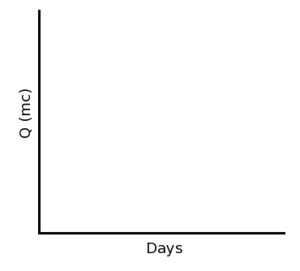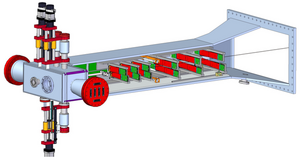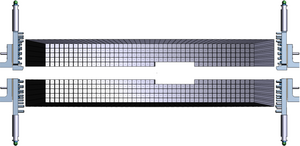Difference between revisions of "The HPS Run Wiki"
| Line 142: | Line 142: | ||
== Run Plan:March 23-24, 2015 (day/swing/owl) == | == Run Plan:March 23-24, 2015 (day/swing/owl) == | ||
| − | Overview: | + | Overview: Upstream BPMs successfully calibrated yesterday. Machine down much of the night with CHL trip and vac trip.Resuming program today. |
| − | + | Program: 1) MCC retunes upstream beam; (2) When beams are acceptable, MCC restores beams to alcove;(3) when have decent beams to alcove, calibrate downstream bpms (4)post calibration, require get good spot on Chromax, low counts on halo counters, and then set-up chicane. 5) scan target vertically and horizontally, halo rates vs target (5) Take data. Subsystem commissioning studies: more trigger commissioning studies, beam trip studies once orbit locks are on. | |
| − | |||
| − | |||
| − | |||
'''<font size=3> MCC works on beam optics and matching, and tunes beam to tagger </font>''' | '''<font size=3> MCC works on beam optics and matching, and tunes beam to tagger </font>''' | ||
| Line 153: | Line 150: | ||
* After MCC finishes beam tune and upstream bpms are calibrated | * After MCC finishes beam tune and upstream bpms are calibrated | ||
** record harp scans at 2C21 and 2C24. These must be good scans, good S/N, no tails, and low halo count rates before proceeding. | ** record harp scans at 2C21 and 2C24. These must be good scans, good S/N, no tails, and low halo count rates before proceeding. | ||
| − | Standards are on this page: ACCEPTABLE BEAM CONDITIONS. | + | Standards are on this page: ACCEPTABLE BEAM CONDITIONS. 2c21 and 2C24 mean x,y should be very close to "golden values" which worked last time. Correctors should also be "golden". |
** make sure no bleedthrough-- counts when no beam? | ** make sure no bleedthrough-- counts when no beam? | ||
| − | ** After beam tune is done send HPS scaler GUI to the logbook with | + | ** After beam tune is done send HPS scaler GUI to the logbook with comments |
'''<font size=3> Restore Beam to the Hall-B Faraday cup Dump and Setup HPS. </font>''' | '''<font size=3> Restore Beam to the Hall-B Faraday cup Dump and Setup HPS. </font>''' | ||
| Line 168: | Line 165: | ||
* Record position at 2H02 harp. Repeat at 10 nA. Must have good spots, nominal sizes, no tail to proceed. Position ok? | * Record position at 2H02 harp. Repeat at 10 nA. Must have good spots, nominal sizes, no tail to proceed. Position ok? | ||
* record scalers and beam location on screen. | * record scalers and beam location on screen. | ||
| + | * establish orbit locks | ||
'''<font size=3> Energize Chicane </font>''' | '''<font size=3> Energize Chicane </font>''' | ||
| Line 175: | Line 173: | ||
<b>Be very careful when changing magnet currents when beams are on. Must enter new current ACCURATELY. Small steps only. </b> | <b>Be very careful when changing magnet currents when beams are on. Must enter new current ACCURATELY. Small steps only. </b> | ||
| − | * Turn beam off and insert HPS target, 4um W | + | * Turn beam off and insert HPS target, 4um W. Restore beam. Check count rates. |
| − | * Do horizontal scan of beam on target. Using table provided, first change Frascati settings, then PS settings to move beam left and right on the target with ~1mm step. Small changes only. Return to nominal beam | + | * Do horizontal scan of beam on target. Using table provided, first change Frascati settings, then PS settings to move beam left and right on the target with ~1mm step. Small changes only. Return to nominal beam position. |
| − | * Do vertical scan of target at fixed beam position. Measure halo counter/ecal rates vs target position. Record data and graph | + | * Do vertical scan of target at fixed beam position. Measure halo counter/ecal rates vs target position. Record data and graph. |
| + | Are we centered? | ||
* Do scan of SVT collimator, measuring counter rates vs SVT collimator position with nominal beam position. | * Do scan of SVT collimator, measuring counter rates vs SVT collimator position with nominal beam position. | ||
* If Omar is available during day or swing, do SVT Wire Scan. This still needs an expert. | * If Omar is available during day or swing, do SVT Wire Scan. This still needs an expert. | ||
| Line 185: | Line 184: | ||
* Make sure DAQ is OK for data taking | * Make sure DAQ is OK for data taking | ||
* More Trigger commissioning data runs. See [[Media:HPS_TriggerCommissioning_March2015.pdf|Valery's note]] on the run Wiki under commissioning trigger. | * More Trigger commissioning data runs. See [[Media:HPS_TriggerCommissioning_March2015.pdf|Valery's note]] on the run Wiki under commissioning trigger. | ||
| − | * | + | * if orbit locks are on, call Rafayel for beam trip study. Take 4 hours of beam trip data with wire up; take 4 hours of beam trip data with wire down. |
* Absent other requests, take data at 50 nA. Be sure to block Faraday cup if higher current. | * Absent other requests, take data at 50 nA. Be sure to block Faraday cup if higher current. | ||
| − | |||
| − | |||
| − | |||
| − | |||
Revision as of 09:56, 24 March 2015
Important Phone NumbersShift ScheduleShift-Taker's Checklist (old)Hot CheckoutBeam Time Accounting |
Procedures |
Manuals |
JLab Logbooks
|
RC: John Jaros
PDL: Stepan StepanyanEvery Shift:
SVT InstructionsBefore sending beam to Faraday cup, verify (and page expert if otherwise):
The first time sending beam to the Faraday cup after the hall is closed, page the SVT expert.
Acceptable Beam Conditions:Before accepting beam, make sure all the conditions are met - beam profile and halo rates are what you expect (or very close to it). If unsure call to RC, PDL, or beamline expert!
Always read previous log entries, compare settings of BPMs and correctors with previous settings using scaler_hps GUI. Every Run:
|
DO NOT RUN MORE THAN 30 MINUTES ABOVE 50 nA WITHOUT THE BEAM BLOCKER Run Plan:March 23-24, 2015 (day/swing/owl)Overview: Upstream BPMs successfully calibrated yesterday. Machine down much of the night with CHL trip and vac trip.Resuming program today. Program: 1) MCC retunes upstream beam; (2) When beams are acceptable, MCC restores beams to alcove;(3) when have decent beams to alcove, calibrate downstream bpms (4)post calibration, require get good spot on Chromax, low counts on halo counters, and then set-up chicane. 5) scan target vertically and horizontally, halo rates vs target (5) Take data. Subsystem commissioning studies: more trigger commissioning studies, beam trip studies once orbit locks are on. MCC works on beam optics and matching, and tunes beam to tagger
Standards are on this page: ACCEPTABLE BEAM CONDITIONS. 2c21 and 2C24 mean x,y should be very close to "golden values" which worked last time. Correctors should also be "golden".
Restore Beam to the Hall-B Faraday cup Dump and Setup HPS.
Energize Chicane
Be very careful when changing magnet currents when beams are on. Must enter new current ACCURATELY. Small steps only.
Are we centered?
Subsystem Commissioning Studies. Begin Data Taking.
| ||||||||||||||||||||||||||||||||||||||||||||||
|
|
| ||||||||||||||||||||||
|
|
|
| ||||||||||||||||||||||||||||||||||||||||||||||
|
Webcams:
|
Slow Controls: |
Accelerator:
|
Offline: |


